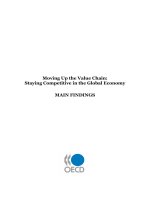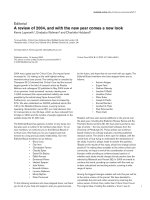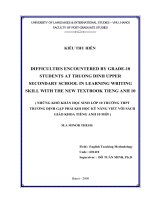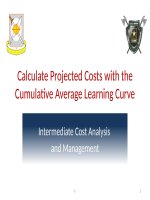Global value building trading models with the 10 year CAPE
Bạn đang xem bản rút gọn của tài liệu. Xem và tải ngay bản đầy đủ của tài liệu tại đây (1.41 MB, 15 trang )
CQR ISSUE 5 | August 2012
GLOBAL VALUE: BUILDING TRADING MODELS
WITH THE 10-YEAR CAPE
ABSTRACT
Over seventy years ago Benjamin Graham and David Dodd
proposed valuing securities with earnings smoothed across
multiple years. Robert Shiller popularized this method with his
version of the cyclically adjusted price-to-earnings ratio (CAPE)
in the late 1990s, and issued a timely warning of poor stock
returns to follow in the coming years. We apply this valuation
metric across more than thirty foreign markets and find it both
practical and useful. Indeed, we witness even greater examples
of bubbles and busts abroad than in the United States. We then
create a trading system to build global stock portfolios based on
valuation, and find significant outperformance by selecting
markets based on relative and absolute valuation.
Mebane T. Faber
The Ivy Portfolio
2321 Rosecrans Avenue
Suite 3225
El Segundo, CA 90245
Phone: 310.683.5500
Fax: 310.683.5505
www.cambriainvestments.com
CQR ISSUE 5 | August 2012
INTRODUCTION – THE FUTILITY OF FORECASTING
Investors spend an inordinate amount of time and effort forecasting stock market direction,
often with very little success. The conventional efficient market theory is that markets are not
predictable and cannot be forecasted. Value has no place in the efficient market ivory tower, but
does it seem reasonable for an investor, or perhaps a retiree, to have allocated the same amount
of a portfolio to stocks in December 1999 versus in 1982? Of course not.
However, valuation is best used as a strategic guide rather than as a short-term timing tool. It is
most useful on a time scale of years and decades rather than weeks and months (or even days).
While we can formulate a hypothesis for where the S&P 500 ‘should’ be trading, the animal
spirits contained in the marketplace invariably cause prices to deviate quite substantially from
‘reasonable’ levels, often for years and even decades.
There are numerous models to consider when valuing stock markets, and a great summary can
be found in a publication by The Leuthold Group titled, “Stock Market Valuation: What Works
and What Doesn’t?” The paper covers a number of models, including price-to-earnings (P/E) on
trailing 12-month earnings per share (EPS), P/E on 5-year normalized EPS, return on equity (ROE)
based normalized EPS, dividend yield, price-to-book, price-to-cash flow, and price-to-sales. In
general they find that many of these metrics are decent at forecasting stock returns. Other
models include the Q-Ratio, and market capitalization to GNP/GDP (Buffett’s favorite). Another
great summary is set forth in the paper “Estimating Future Stock Market Returns” by Adam
Butler and Mike Philbrick.
We are not going to summarize all of the stock valuation models in existence, but rather focus on
just one. Often, in individual stocks as well as in stock markets, many of the value metrics end up
producing broadly similar statistics and fair value estimates. We direct the readers to the
Appendix as well as our blog World Beta where we list links to other papers and resources
mentioned in this paper if they wish to explore other models more in depth.
A SIMPLE MODEL – TEN YEAR NORMALIZED EARNINGS
Benjamin Graham and David Dodd are universally seen as the fathers of valuation and security
analysis. In their 1934 book “Security Analysis” they were early pioneers in comparing stock
prices with earnings smoothed across multiple years, preferably five to ten years. Using
backward looking earnings allows the analyst to smooth out the business and economic cycle, as
well as price fluctuations. This long-term perspective dampens the effects of expansions as well
as recessions.
Robert Shiller, the author and Yale professor, popularized Graham and Dodd’s methods with his
version of this cyclically adjusted price-to-earnings ratio (CAPE). His 1998 paper “Valuation
Ratios and the Long-Run Stock Market Outlook” was shortly followed by his book “Irrational
Exuberance” that included a warning on overvaluation prior to the 2000 stock market crash.
2
CQR ISSUE 5 | August 2012
Shiller maintains a website with an Excel download that includes historical data with formulas
illustrating how to construct his ten year CAPE. For a step-by-step guide Wes Gray at Turnkey
Analyst has a good post that walks through the steps necessary to construct the metric.
One common criticism of the CAPE is that the measurement period of ten years is too long.
Critics claim recessions and expansions have an outsized impact long after they have faded from
memory. “Estimating Future Stock Market Returns” by Adam Butler and Mike Philbrick tackles
the issue of different measurement periods from one year up to thirty (as well as other valuation
models). Critics also claim adjustments to CPI and accounting rules render comparisons across
decades, or even centuries meaningless. While we agree there may be some variation, later in
the paper we examine the CAPE in over 30 foreign markets with supporting results.
Figure 1 below is a chart of the CAPE going back to 1881. The long-term series spends about half
of the time with values ranging between 10 and 20, with an average and median value of about
16. The all-time low reading was 5, reached at the end of 1920, and the high value of 45 was
reached at, you guessed it, the end of 1999.
FIGURE 1
US 10-YEAR CAPE
1881 - 2011
Source: Shiller
Asset allocators that believe in efficient markets allocate the same percentage of assets to
equities when valuations are high as they do when valuations are low. But does that seem even
remotely reasonable looking at the above chart?
3
CQR ISSUE 5 | August 2012
THE 10 BEST, AND WORST, TIMES IN HISTORY TO INVEST
To illustrate this point, we examined all year-end periods with a holding period for the next ten
years. What have been the ten best, and worst, years to invest since 1871? Figure 2 details
these years and their corresponding ten-year compounded real returns.
Many of the best starting points seem obvious in retrospect. 1948 and 1949 were great entries,
preceding the Nifty Fifty mania, and of course 1918-1920 and the upcoming Roaring Twenties are
on the list. 1988 and 1989 certainly would not be left out with the Internet bull market ahead as
well.
The same hindsight applies for the bad years as they often fell at the end of these massive bull
runs. Bear markets set the stage for future bull markets and vice versa.
One simple take away from Figure 2 below is the valuations at the start of these ten-year
periods. The average valuation for the ten best years was 10.92. The average valuation for the
ten worst years was 23.31, double that of the best starting points.
FIGURE 2
US STOCK REAL RETURNS VS. 10-YEAR CAPE
1881 - 2011
Source: Shiller. Index returns are for illustrative purposes only. Indices are unmanaged and an investor cannot
invest directly in an index. Past performance is no guarantee of future results.
BUY LOW, SELL HIGH
In Figures 3a and 3b, we examine a table of all of the CAPE yearly readings at the end of the year
from 1881 – 2011. We list how often they occur, as well as the real forward returns. The red bar
in Figure 3b is where we find ourselves as of the summer of 2012.
4
CQR ISSUE 5 | August 2012
What we find is no surprise, it very much matters what price one pays for an investment! Indeed
it is an almost perfect stair step - future returns are lower when valuations are high, and future
returns are higher when valuations are low.
FIGURE 3A
US STOCK AVERAGE REAL COMPOUND RETURNS VS. 10-YEAR CAPE
1881 - 2011
CAPE
<5
5 to 10
10 to 15
1 Year fwd 3 Year fwd 5 Year fwd 7 Year fwd
Rea l CAGR Rea l CAGR Rea l CAGR Rea l CAGR
% occurrence
0.8%
25.4%
18.9%
21.6%
22.6%
17.1%
14.5%
12.6%
12.6%
11.6%
10 Year fwd
Real CAGR
15.8%
10.5%
26.4%
10.6%
8.3%
6.7%
6.5%
8.1%
15 to 20
31.0%
6.4%
4.7%
5.2%
5.3%
5.2%
20 to 25
15.5%
1.6%
5.4%
4.9%
4.3%
2.7%
25 to 30
5.4%
1.3%
-1.0%
-1.3%
1.5%
3.3%
30 to 40
3.1%
1.9%
0.3%
-1.1%
-0.5%
-0.3%
40 to 50
0.8%
-12.5%
-17.0%
-4.8%
-1.5%
-3.5%
Source: Shiller. Index returns are for illustrative purposes only. Indices are unmanaged and an investor cannot
invest directly in an index. Past performance is no guarantee of future results.
FIGURE 3B
US STOCK AVERAGE REAL COMPOUND RETURNS VS. 10-YEAR CAPE
1881 - 2011
Source: Shiller. Index returns are for illustrative purposes only. Indices are unmanaged and an investor cannot
invest directly in an index. Past performance is no guarantee of future results.
5
CQR ISSUE 5 | August 2012
While more sophisticated models can be built, below is a simple figure of an inverse CAPE and
future 10-year real stock returns – shockingly similar. John Hussman has a few good articles on
this topic: “Estimating the Long Term Returns on Stocks” and “The Likely Range of Market
Returns in the Coming Decade” Joachim Klement also recently published the paper, “Does the
Shiller-PE Work in Emerging Markets?” that performs a similar analysis.
FIGURE 4
US STOCK 10-YEARE REAL COMPOUND RETURNS VS. 10-YEAR CAPE
1881 - 2011
Source: Shiller. Index returns are for illustrative purposes only. Indices are unmanaged and an investor cannot
invest directly in an index. Past performance is no guarantee of future results.
VALUTION AND INFLATION
Besides general sentiment, what might cause this large variation in what multiples investors are
willing to pay for stocks? After all, at a current value of around 1374, this means the S&P 500
could trade at either 315 or 2800 based on historical low and high multiples of 5 and 45,
respectively. It is difficult for most investors to comprehend the possibility of stocks declining
80% or increasing over 100%, but both of these multiples have occurred in the past.
One of the determinants of the valuation multiple investors are willing to pay is the inflation rate
as seen in Figure 5. The red bar is where we find ourselves as of the summer of 2012. When
inflation is in the 1-4% “comfort zone”, investors are willing to pay a valuation premium
6
CQR ISSUE 5 | August 2012
compared to when there is either high inflation or outright deflation. Rob Arnott of Research
Affiliates touches on this important topic in his white paper, “King of the Mountain.” Two other
books speak of CAPEs and inflation/deflation levels. The first is Unexpected Returns:
Understanding Secular Stock Market Cycles by Ed Easterling, and John Mauldin’s Bull's Eye
Investing: Targeting Real Returns in a Smoke and Mirrors Market.
FIGURE 5
SHILLER CAPE VS. INFLATION LEVELS
1880 - 2011
Source: Shiller, Arnott. Index returns are for illustrative purposes only. Indices are unmanaged and an investor
cannot invest directly in an index. Past performance is no guarantee of future results.
GLOBAL CAPE
There is very little in the literature regarding global CAPEs for international equity markets. One
such resource is Russell Napier, who authored Anatomy of the Bear: Lessons From Wall Street's
Four Great Bottoms, and who discusses global CAPEs in a video here. We also found two great
recently published papers by Joachim Klement– “Does the Shiller-PE Work in Emerging
Markets?”, and “Value Matters: Predictability of Stock Index Returns” by Angelini, Bormetti,
Marmi, and Nardini.
We examined 32 countries with data from Global Financial Data and Morningstar, including as
much data as we could find. We realize there is some bias in this study (if you have German PE
data to 1685 or French to 1724 please contact us), but we did the best with what we have. We
utilized local real returns (and found dollar based real returns to be nearly identical) to net out
the effects of inflation.
7
CQR ISSUE 5 | August 2012
While only two had century long data (US and UK), most of the other countries go back to the
1970s and 1980s.
FIGURE 6
GLOBAL COUNTRIES INCLUDED IN STUDY AND 10-YEAR CAPE
AS OF JUNE 2012
Country
Australia
Austria
Belgium
Brazil
Canada
Chile
China
France
Germany
Greece
Hong Kong
India
Indonesia
Ireland
Italy
Japan
Malaysia
Mexico
Netherlands
Portugal
Russia
Singapore
South Africa
South Korea
Spain
Sweden
Switzerland
Taiwan
Thailand
Turkey
UK
USA
Latest
Min
Max
Median
12.87
7.66
9.06
11.63
17.31
22.81
14.30
10.53
12.07
2.04
15.27
18.63
24.25
4.97
6.54
14.09
20.15
20.77
9.95
7.20
7.16
12.18
16.58
15.14
8.49
14.17
14.37
13.69
15.09
13.64
12.41
20.88
7.65
6.04
4.88
11.04
5.83
9.71
14.30
6.20
7.83
1.95
8.55
12.69
5.05
3.02
5.92
13.27
7.77
11.69
4.62
7.02
5.13
9.40
10.16
4.74
7.25
4.82
7.12
9.18
3.00
8.24
4.43
4.72
31.60
59.11
29.49
29.73
63.33
32.95
61.98
57.16
56.86
39.81
34.55
47.80
34.96
18.25
52.91
94.25
26.50
35.33
38.52
39.36
22.88
37.80
24.12
27.65
40.06
74.18
57.94
42.28
17.97
42.96
28.69
45.08
17.15
26.80
14.89
17.34
19.85
20.93
24.40
19.92
17.90
15.91
18.16
24.56
16.37
10.94
21.66
43.89
18.49
19.62
11.95
16.43
9.15
21.96
16.22
17.84
17.33
19.54
18.16
19.43
11.48
17.02
11.84
14.63
Source: Global Financial Data Index returns are for illustrative purposes only. Indices are unmanaged and an
investor cannot invest directly in an index. Past performance is no guarantee of future results.
8
CQR ISSUE 5 | August 2012
We examined all the countries on a yearly basis since 1980, CAPE levels, and future returns. The
sample includes approximately 10 counties in 1980, 20 in 1990, and 30 by 2000. The results are
in the table below and largely confirm the US data. Buy low, sell high.
FIGURE 7
10-YEAR CAPE LEVELS AND FUTURE AVERAGE REAL COMPOUND RETURNS FOR 32 COUNTRIES
1980 - 2011
Avg CAPE
by Bucket
<10
10 to 15
15 to 20
20 to 25
25 to 30
30 to 40
40 to 50
>50
%
occurrence
10.2%
20.5%
25.2%
18.3%
11.0%
7.5%
4.4%
2.0%
1 Year
Real CAGR
25.9%
22.8%
11.2%
4.4%
-1.3%
3.0%
-3.3%
-4.5%
3 Year
Real CAGR
17.0%
13.8%
10.8%
6.8%
0.7%
-1.1%
-3.4%
-12.3%
5 Year
Real CAGR
17.1%
12.2%
10.6%
5.6%
3.4%
-0.8%
0.0%
-6.4%
7 Year
Real CAGR
13.4%
11.2%
8.8%
6.5%
3.4%
1.7%
0.2%
-1.9%
10 Year
Real CAGR
10.9%
9.6%
8.0%
5.7%
3.3%
2.1%
-0.2%
-3.1%
Source: Global Financial Data, Morningstar. Index returns are for illustrative purposes only. Indices are unmanaged
and an investor cannot invest directly in an index. Past performance is no guarantee of future results.
We found most CAPEs averaged around 15-20, bottomed out around 7, and maxed out around
45 (and a few made the United States bubble in the late 1990’s look pathetic in comparison, like
Japan reaching a value of nearly 100 in 1989).
THE BEST OF TIMES, THE WORST OF TIMES
Similarly, do the extremes in valuation signal bubbles and generational buying opportunities?
We examined at the database for all instances where CAPEs were below 5 at the end of the
year. We also included the longer US and UK datasets here for some context. We only found
nine out of about 850 total market years: the US in 1920, the UK in 1974, the Netherlands in
1981, South Korea in 1984, 1985, and 1997, Thailand in 2000, Ireland in 2008, and…Greece in
2011.
Can you imagine investing in any of these markets in those years? In every instance the news
flow was horrendous and many of these countries were in total crisis.
Now what would happen if you invested in these seemingly deplorable markets, the literal worst
of the most disgusting geopolitical headlines? Below are local country real returns (net of
inflation):
CAGR
1 Year
3 Year
5 Year
10 Year
35%
30%
20%
12%
9
CQR ISSUE 5 | August 2012
Likewise, there are only six instances where countries ended the year with CAPE values over 50.
Malaysia in 1993, Japan in 1986-1990, 1999, 2005, and 2006, Italy in 2000, India and China in
2007, and Austria in 1991. The Internet bubble in the US narrowly missed the mark with a value
of 45 in December 1999. But wow talk about a list of awful times to invest!
Below are local country real returns, on average:
CAGR
1 Year
3 Year
5 Year
10 Year
-15%
-9%
-6%
-3%
Source: Global Financial Data, Morningstar. Index returns are for illustrative purposes only. Indices are unmanaged and an
investor cannot invest directly in an index. Past performance is no guarantee of future results.
A GLOBAL STOCK TRADING SYSTEM
The next question is, can we turn this into a trading system? There is evidence that sorting
countries on other measures of value works well. A good summary of the dividend literature can
be found in the Tweedy Browne paper entitled, “The High Dividend Return Advantage.” In the
paper they summarize a 1991 study by Michael Keppler titled, “The Importance of Dividend
Yields in Country Selection“ that found that ranking the universe of countries by dividend yield
also resulted in outperformance. He found that the highest yielding countries outperformed the
lowest yielding from 1969-1989 by more than 12 percentage points per year.
Running a similar study using a different database (Global Financial Data), we sorted countries by
quartiles from 1920-2011, beginning with nine countries and expanding to eighteen by study
end. We found that countries in the highest dividend paying quartile outperformed the
countries in the lowest paying quartile by 11 percentage points per year. (Also see the Appendix
for tests on book value, dividends, cash flow, and earnings.)
We then set out to test CAPE in a similar manner. Starting in 1980 we sort all countries by CAPE,
and invest in the most undervalued x%, rebalanced yearly. We also show the effects of investing
in the most overvalued x% as well as a long/short portfolio. These returns are real returns net of
inflation, and with yearly data (which will naturally understate drawdown figures). The sample
10
CQR ISSUE 5 | August 2012
FIGURE 8
PORTFOLIOS SORTED ON CAPE LEVELS, REAL RETURNS
1980 - 2011
Source: Global Financial Data, Morningstar. Index returns are for illustrative purposes only. Indices are unmanaged and an
investor cannot invest directly in an index. Past performance is no guarantee of future results.
includes approximately 10 counties in 1980, 20 in 1990, and 30 by 2000. Investing in the
cheapest countries produces four to seven percentage points of outperformance, and an equal
amount of underperformance for the overvalued countries. The spread is approximately similar
as the previously mentioned dividend studies, albeit slightly lower. However, investing in the
cheapest countries on a relative basis does not protect the investor when all countries are
expensive in a global equity bubble like 1999.We repeated the same study, but only invested
long if the country was below a CAPE of 15, and only short above a CAPE of 30. If the country
does not qualify for the valuation filter then that part of the portfolio sits in cash (although we do
not receive any interest income in this test).
11
CQR ISSUE 5 | August 2012
FIGURE 9
PORTFOLIOS SORTED ON CAPE LEVELS, REAL RETURNS
1980 - 2011
Source: Global Financial Data, Morningstar. Index returns are for illustrative purposes only. Indices are unmanaged
and an investor cannot invest directly in an index. Past performance is no guarantee of future results.
For the most part, adding the absolute CAPE level filter results in better performance with lower
drawdowns. This is to be expected as the portfolio could be sitting in 20%, 50%, or even 100%
cash (like 1999 or 2007). In this case the returns are higher as well. As many investors look at
this table and salivate over the prospect of 15% real returns, recall Figure 6 and note that most of
the cheapest countries fall in the troubled Eurozone. How many investors have the stomach to
invest in these countries with potential for the markets to get even cheaper? How many
professional investors would be willing to bear the career risk associated with being potentially
wrong in buying these markets?
Figure 10 on the following page depicts the equity curves from taking the cheapest 33% of
countries (also with filter), the most expensive 33% of countries, and the equal weight
benchmark.
12
CQR ISSUE 5 | August 2012
FIGURE 10
PORTFOLIOS SORTED ON CAPE LEVELS, REAL RETURNS
1980 - 2011
Source: Global Financial Data, Morningstar. Index returns are for illustrative purposes only. Indices are unmanaged and an
investor cannot invest directly in an index. Past performance is no guarantee of future results.
SUMMARY
Warren Buffett famously said, “Price is what you pay. Value is what you get.” Over periods of
years and decades it is evident that an investor’s real return is heavily dependent on the price
paid for the asset. Investors can use CAPE valuation as a guidepost for both opportunities arising
from negative geopolitical events, as well as a sanity check against bubbling stock markets.
Comparing global equity markets on a relative basis allows the portfolio manager to create
portfolios of cheap stocks markets, while avoiding or even shorting expensive markets.
13
CQR ISSUE 5 | August 2012
APPENDIX A – Other Valuation Models
Samuel Lee has a great article “The Hedgehog’s Error” on Morningstar that sorts global countries
based on value (Price/Book) using the French Fama database. Not surprisingly, he finds that
sorting on value works well.
We utilize the database to sort the countries (twelve in 1975 and rising to twenty by 1991) based
on various measure of value. Below in Figure A we demonstrate the results of sorting the
countries on a yearly basis and choosing the cheapest X% of the universe (from 33% to 10%).
Below are results that are US dollar based, nominal.
FIGURE A
1975 - 2011
33%
B&H
Book
Earnings
Cash Flow
Dividends
CAGR
12.7%
13.5%
15.6%
13.2%
14.3%
STD
22%
24%
24%
25%
24%
MaxDD
47%
46%
50%
46%
49%
25%
B&H
Book
Earnings
Cash Flow
Dividends
CAGR
12.7%
15.4%
14.3%
14.0%
14.9%
STD
22%
25%
26%
25%
24%
MaxDD
47%
43%
61%
46%
46%
10%
B&H
Book
Earnings
Cash Flow
Dividends
CAGR
12.7%
18.1%
16.4%
13.5%
12.9%
STD
22%
29%
28%
34%
26%
MaxDD
47%
38%
54%
55%
48%
Source: Global Financial Data, Morningstar, Fama & French. Index returns are for illustrative purposes only. Indices are
unmanaged and an investor cannot invest directly in an index. Past performance is no guarantee of future results.
14
CQR ISSUE 5 | August 2012
DISCLAIMERS
Cambria Investment Management, LP.
(“CIMI”) is an investment adviser registered
under the Investment Advisors Act of 1940
with the U.S. Securities and Exchange
Commission (SEC).
This publication is for informational purposes
only and reflects the current opinions of CIMI.
Information contained herein is believed to be
accurate, but cannot be guaranteed. This
material is based on information that is
considered to be reliable, but CIMI and its
related entities make this information
available on an “as is” basis and make no
warranties, express or implied regarding the
accuracy or completeness of the information
contained herein, for any particular purpose.
CIMI will not be liable to you or anyone else
for any loss or injury resulting directly or
indirectly from the use of the information
contained in this newsletter caused in whole
or in part by its negligence in compiling,
interpreting, reporting or delivering the
content in this newsletter.
Opinions represented are not intended as an
offer or solicitation with respect to the
purchase or sale of any security or financial
instrument, nor is it advice or a
recommendation to enter into any
transaction. The material contained herein is
subject to change without notice. Statements in
this material should not be considered
investment advice. Employees and/or clients of
CIMI may have a position in the securities
mentioned. This publication has been prepared
without taking into account your objectives,
financial situation or needs. Before acting on
this information, you should consider its
appropriateness having regard to your
objectives, financial situation or needs. CIMI is
not responsible for any errors or omissions or
for results obtained from the use of this
information. Nothing contained in this
material is intended to constitute legal, tax,
securities, financial or investment advice, nor
an opinion regarding the appropriateness of
any investment. The general information
contained in this material should not be acted
upon without obtaining specific legal, tax or
investment advice from a licensed
professional. Past performance is not a guide
to future performance, future returns are not
guaranteed, and a loss of all of the original
capital invested in a security discussed in this
newsletter may occur. It is your responsibility
to be aware of and observe the applicable
laws and regulations of your country of
residence.
There are inherent limitations in hypothetical
portfolio results as the securities are not
actually purchased or sold. They may not
reflect the impact, if any, that material
economic and market factors might have
had on the investment manager’s decisionmaking if the hypothetical portfolios were
real. Indices mentioned are used for
comparison purposes, are related to the
market in a broad sense and thus may differ
from the model portfolios in their level of
volatility. Indices are unmanaged and
cannot be invested in directly. The backtested data relates only to a hypothetical
model of past performance of the GTAA
strategy itself, and not to any asset
management products based on this index.
No allowance has been made for trading
costs or management fees which would
reduce investment performance. Actual
results may differ. Returns represent backtested performance based on rules used in
the creation of the index, are not a
guarantee of future performance and are
not indicative of any specific investment.


![development with the force.com platform [electronic resource] building business applications in the cloud](https://media.store123doc.com/images/document/14/y/zs/medium_Qs04cLaWf8.jpg)






